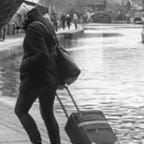Shanghai’s Pentagon
*Caroline Knowles
Another of Shanghai’s replicas, radically different from the gentility of Thames Town, is The Pentagon. Three or five storeys high in places with connecting walkways at the upper levels, The Pentagon looks like what it is: something partially built in broken grey concrete and exposed cables. Endless interconnected spaces like underground parking garages enfolded in eerie darkness stretch into the distance. Between piles of building debris, layers of dirt cover the glass in large windows. Escalators stand motionless. Missing steps leave gaping holes, providing a treacherous staircase to the upper levels. The lifts are grounded on the first floor; doors permanently jammed open.
Higher levels of broken atria are visible from the ground floor. Next to an abandoned brown leather sofa coated in dust, an adolescent boy sits in an office chair in an open space, deeply absorbed with his mobile phone. He is wearing only one black plastic boot with white bug eyes on it. The gloom and dust stretch into the infinite distance behind him. Sarajevo’s Bus Station aside, The Pentagon is the most unsettling urban space I have ever visited.
The Pentagon is in Shanghai’s Pudong District southeast of the city centre. It was designed as a replica of the other Pentagon — the Virginia Head Quarters of the US Defence Department. It’s not clear why. But drone footage from 2016 confirms that it is indeed a copy of the distinctive architecture of the US Pentagon. Only of course it is bigger — 70 acres, or so it is claimed.
Built in 2009, the Shanghai Pentagon was intended to be the world’s biggest shopping mall. Its owners claimed to have signed thousands of commercial tenants, western brands among them. It is reported — I did not see this for myself — that a Sphinx and the Arc de Triumph were grafted on to the outside of the building and that a roller coaster would be built inside. As ever, it is difficult to distinguish fantasies of intention from what actually happens on the ground. Underpinning The Pentagon were imaginary shoppers: it would attract hundreds of thousands of shoppers each day. Boosting domestic consumption was at that time — and remains — understood to drive economic growth.
But that’s not the end of the story. There are shoots of optimism and more realistic plans. This rotten tail is being revived — developing an end to its unfinished story. My colleague’s student and I fell on parts of the Pentagon being repurposed. A man in overalls in a cherry-picker was improving the lighting. Lights shone on stalls heaped with watermelons, peaches, berries, black and green grapes, bright red shrimps in buckets, all kinds of fish, containers crammed with yellow frogs beneath white netting preventing their escape. There were meat stalls, stalls selling household goods, grains, jars full of yellow liquid and twisted roots, flagons of local wine. The provisions of daily life.
Cloud stood tall among the fruit on her stall as we stopped to buy a pineapple she delicately prepared with a sharp knife. She wore slim navy trousers, a white blouse and ballerina shoes. As we were approaching her stall, she was stretching onto her tip toes, her arms high above her head, her palms facing the ceiling. ‘Propping up the sky’ is what this pose is called in yoga, and I think this is what she is doing. Not the owner of the stall, she tells us that she works long shifts for a small wage. Over the last year, she reports, this part of The Pentagon is slowly infolding as a giant affordable local market instead of a luxury mall.
Leaving the site to get back to metro line 10, we see that construction is underway. Hopefully, like the market, something local people can use or somehow benefit from is being built. Talking of consumption, it is time to move on to China’s consumption HQ; to Yiwu, a city which is south and slightly west of Shanghai and an hour and a half away by fast train. It’s time to move on.
*Caroline Knowles is an urban sociologist and the author of Serious Money: Walking Plutocratic London, published by Penguin (2022) https://seriousmoneybook.com and a Global Professorial Fellow at Queen Mary, University of London.
